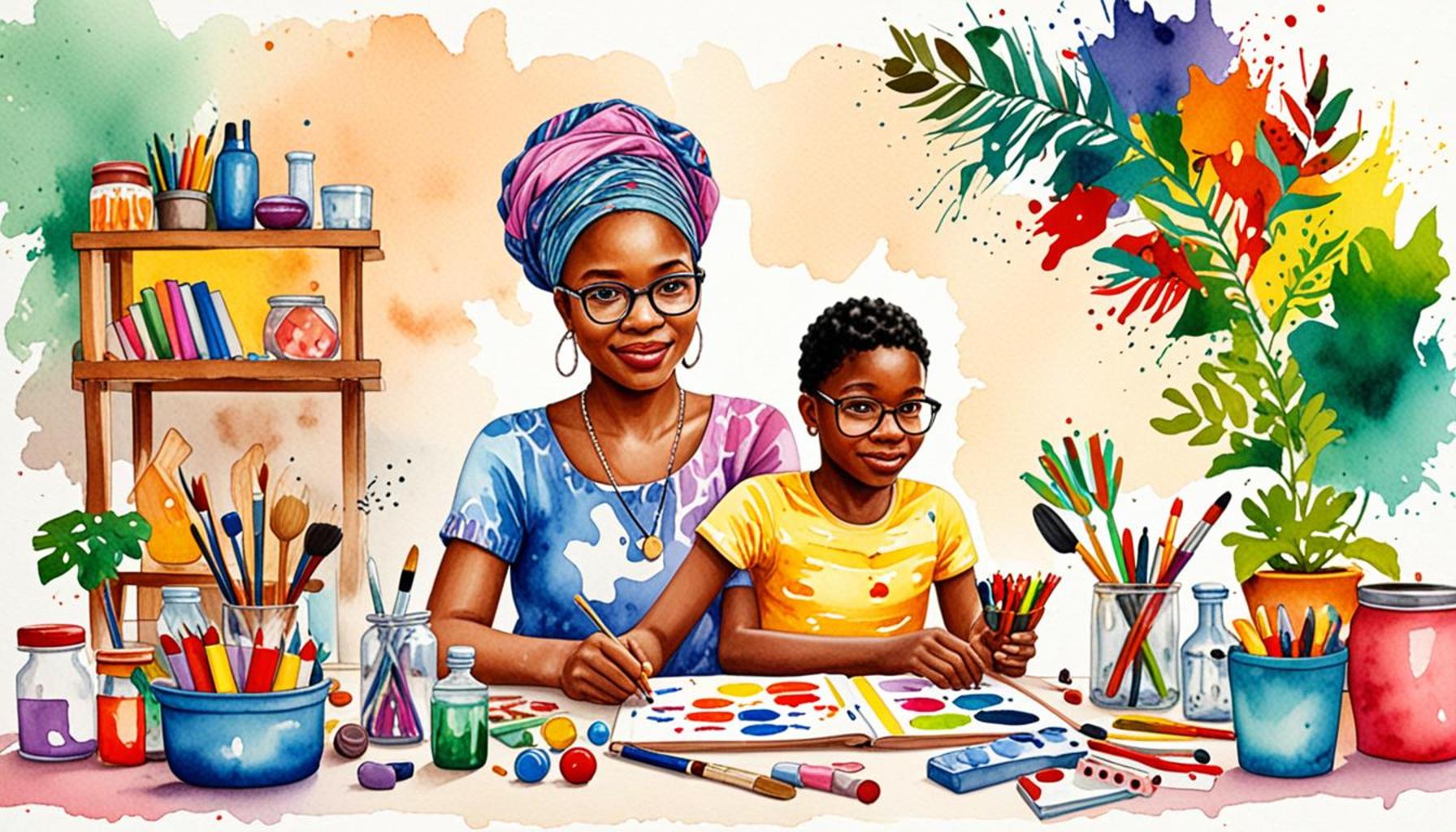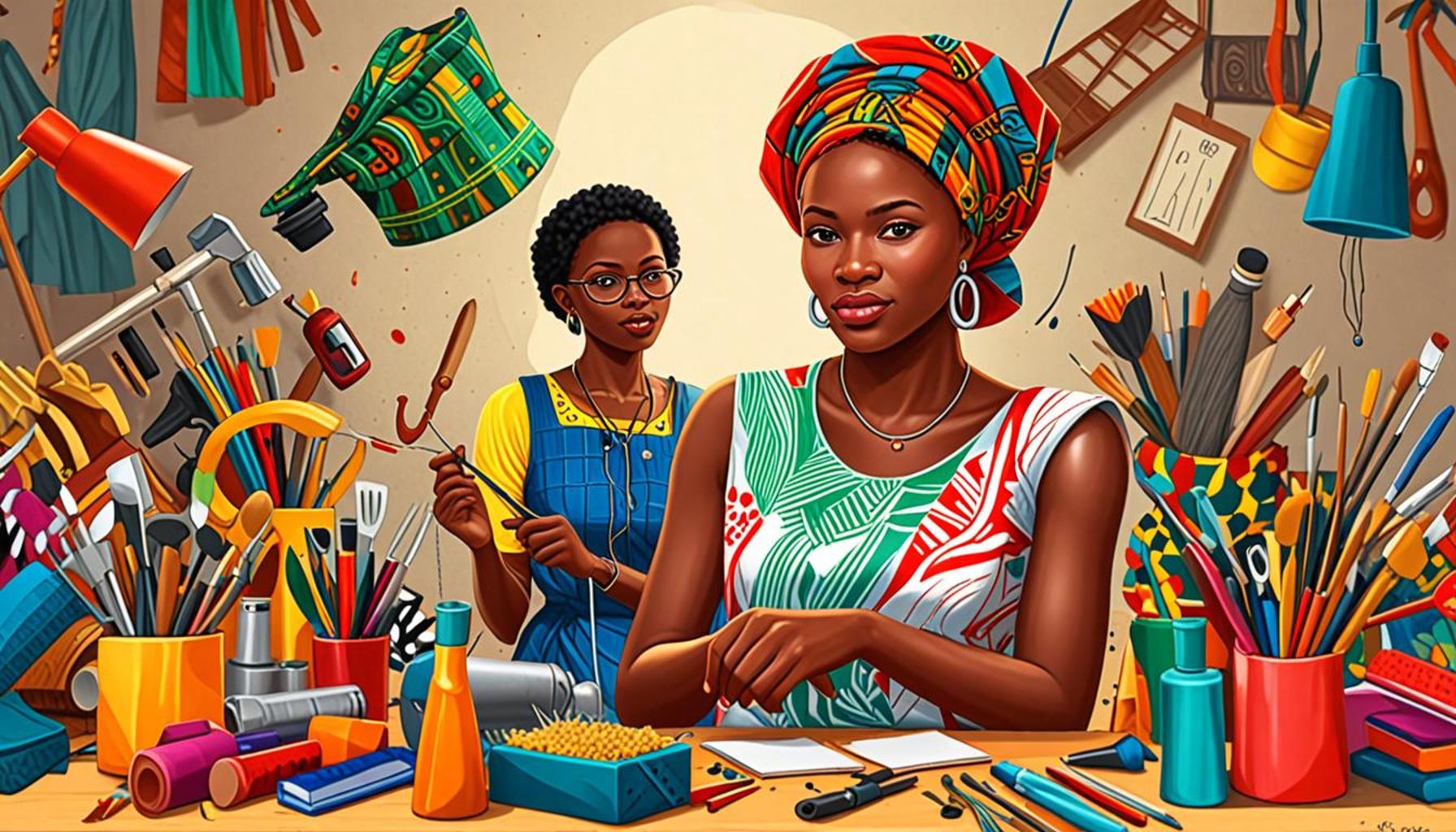The Role of Inclusive Design in Craft Innovation: Creating Accessible Products for Everyone in Nigeria

The Importance of Inclusive Design in Craft Innovation
In a world where the need for inclusivity is more pronounced than ever, design plays a pivotal role in ensuring that everyone can participate and thrive. Nigeria, with its extensive array of cultures and communities, provides fertile ground for craft innovation. By embracing inclusive design, the craft sector can evolve to offer products that cater to the diverse needs of the population, making artisanal goods accessible and beneficial for all.
Key Principles of Inclusive Design in Crafting
- Accessibility: Craft products should serve individuals with varying abilities. For instance, consider the design of furniture that accommodates wheelchairs, or mobility aids integrated into home décor. Artisans can create tools and products that are user-friendly for people with visual impairments by incorporating tactile elements and braille labels, ensuring that no one is left out.
- Affordability: Economic barriers often prevent individuals from various social strata from enjoying artisanal creations. Craft innovations should be economically accessible, designed in a way that allows for streamlined production without compromising quality. For example, if artisans can produce goods using locally sourced materials, it can reduce costs and offer affordability while supporting the local economy.
- Diversity: Nigeria is celebrated for its rich traditions, languages, and customs. Designs that reflect local heritage not only honor these roots but resonate profoundly with a wider audience. Consider the use of indigenous patterns or storytelling through craft, which can appeal to both local and global markets. This approach not only fosters a sense of identity and pride but also attracts diverse customers seeking authentic experiences.
Prioritizing inclusive design empowers craftspeople to create products that serve a larger purpose beyond functionality. It promotes fairness, enriches community ties, and opens doors to market opportunities for artisans throughout Nigeria. As trends shift towards prioritizing accessibility, Nigerian artisans have the unique chance to take the lead in championing innovation that celebrates the value of inclusivity.
Inspiring Stories and Local Practices
Nigerian artisans are already paving the way for inclusive design. For example, the story of a cooperative in Lagos made up of artisans with disabilities who create beautiful handcrafted jewelry showcases not just creativity but an inspiring commitment to accessible design. They leverage local materials, ensuring that their products are affordable while employing members of the community who otherwise might struggle to find work.
Through initiatives like craft fairs that highlight inclusive designs, communities can witness firsthand the transformative power of creativity. As we explore further into this topic, it becomes clear that inclusive design is not merely a trend; it is a profound shift towards a future where everyone can partake in and contribute to the beautiful world of crafting. Join us on this journey to discover more about the remarkable changes happening in Nigeria’s craft sector.
LEARN MORE: This related article may interest you

Driving Change Through Inclusive Craft Innovation
The landscape of craft innovation in Nigeria is laden with opportunities, particularly as the nation embarks on fostering inclusivity through innovative design practices. As artisans navigate the complexities of cultural heritage and modern demand, the principle of inclusive design has emerged as a transformative force. By intentionally crafting products that embrace the diverse abilities, preferences, and economic capabilities of all community members, artisans can redefine accessibility in the crafting sector.
To grasp the significance of inclusive design, it is essential to acknowledge the multifaceted nature of Nigeria’s population. With over 250 ethnic groups, each possessing unique artistic expressions, the potential for diversified craft offerings is immense. Yet, despite this wealth of cultural capital, a significant portion of the population faces barriers to accessing traditional and contemporary craft products, primarily due to physical, economic, and social limitations. This is where inclusive design plays a crucial role, ensuring that everyone, regardless of their background, has the opportunity to experience the beauty and functionality of crafted goods.
Real-World Applications of Inclusive Design
The integration of inclusive design principles in craft innovation has led to tangible outcomes that benefit both artisans and consumers. Here are several applications that illustrate how this approach can transform the crafting landscape:
- Adaptive Artistry: Artisans are increasingly developing products that cater to individuals with disabilities. For example, furniture pieces that are specifically designed for individuals who are wheelchair users can enhance the functionality and aesthetic appeal of homes while promoting inclusion within living spaces.
- Culturally Relevant Tools: Employing locally sourced materials can lead to the development of tools and products that resonate with both the environment and the community. Craft innovations that include elements of traditional craftsmanship while addressing modern accessibility needs help bridge the gap between cultures and generations.
- Collaborative Workshops: Engaging community members in inclusive craft workshops not only empowers artisans but also creates a platform for sharing knowledge and experiences. These workshops encourage dialogue around accessibility, fostering a culture of innovation where ideas can flourish.
A notable example comes from the northern region, where artisans have embarked on creating accessible household items using traditional weaving techniques. By collaboratively working with community members who have disabilities, these artisans have developed designs that are as functional as they are beautiful, appealing to a broad audience while serving a pressing need.
As we delve deeper into the conversation surrounding craft innovation and inclusive design, it becomes increasingly clear that these concepts are intertwined. They not only honor Nigeria’s rich artistic heritage but also pave the way for a future where creativity knows no bounds. By investing in inclusive practices, Nigerian artisans are not just producing goods; they are cultivating a movement that prioritizes community, collaboration, and accessibility for all.
| Advantages | Impact on Communities |
|---|---|
| Enhanced Market Reach | Including diverse needs allows products to appeal to a broader audience, increasing potential sales. |
| Empowerment | Access to well-designed products gives individuals greater independence, fostering self-sufficiency and confidence. |
| Community Inclusion | Promotes social cohesion as various groups feel represented, bridging gaps between diverse populations. |
| Innovative Solutions | Drives creativity in designing unique products that cater to specific needs, setting trends in the market. |
In Nigeria, inclusive design serves as a catalyst for transforming craft innovation in various sectors. By prioritizing accessibility, artisans and designers can create products that meet the diverse needs of all individuals, particularly those living with disabilities. For example, incorporating tactile elements into products helps visually impaired users interact with them effectively. Accessible design approaches not only satisfy basic usability but also promote a stronger sense of belonging among individuals with varied abilities.Moreover, the rise of inclusive design positively influences the local economy. Craft industries that embrace these principles frequently experience increased demand as marginalised groups find products tailored to their specific requirements. The focus on accessibility often leads to sustainable practices, where artisans craft goods from locally sourced materials, thereby supporting the environment and bolstering community ties.Through creative collaborations, incorporating insights from consumers directly contributes to continuous improvement in product offerings. Consequently, this fosters an environment where innovation flourishes, enabling Nigerian craftsmen and women to showcase their talents while producing goods that resonate on a global scale.
RECOMMENDED: Check out this similar article
Innovation Through Accessibility: A Focus on Local Communities
At the heart of transforming craft innovation in Nigeria lies a commitment to community engagement. As artisans adopt inclusive design principles, they are increasingly aware of the importance of catering to the unique needs of their local environments. This not only creates accessible products but also actively involves community members in the design process, ensuring that the outputs reflect the collective aspirations and realities of the people.
One striking example of this community-driven approach is in the southwest region of Nigeria, where artisans are utilizing local clay to produce handmade pottery designed for all users, including the elderly and individuals with dexterity challenges. By redesigning traditional pottery forms to include larger grips and lighter weights, these artisans have broadened the reach of their products, enabling more people to partake in cultural expressions through pottery. This technique not only keeps traditional skills alive but also transforms the way these products are perceived and interacted with.
The Role of Technology in Inclusive Design
In an age dominated by technology, the integration of tech solutions into craft innovation has opened new avenues for accessibility. For instance, artisans are beginning to incorporate 3D printing technologies into their workshops, allowing them to create prototypes that are both customizable and functional. This technology gives artisans the ability to rapidly iterate and adapt designs based on feedback from diverse community members. Products like assistive devices—such as adaptive kitchen tools or seating options—can transition from concept to reality with astonishing speed, directly responding to the needs expressed by users.
Additionally, social media platforms play a pivotal role in creating awareness around accessible craft products. Artisans leverage these platforms to showcase their work, facilitating discussions that highlight innovations while educating consumers on the benefits of inclusive design. Case studies of brands that have successfully integrated accessibility into their marketing strategies highlight the potential for an expanded customer base, as consumers increasingly seek products that embrace inclusivity.
Market Trends and Economic Impact
The economic implications of implementing inclusive design are substantial. Market research indicates that a dedicated approach to inclusivity can lead to a significant increase in consumer demand. By catering to overlooked demographics—such as individuals with disabilities, the elderly, and low-income households—artisans not only enhance their sales potential but also contribute to the broader economy. Inclusive design positions these craftsmen as leaders, drawing attention to ways that creativity can intersect with commerce, fostering a market that values accessibility without compromising artistic integrity.
Moreover, government and non-governmental organizations (NGOs) are beginning to take note of the potential that inclusive design holds for driving economic development in Nigeria’s craft sector. Initiatives that provide training and resources for artisans in inclusive practices not only elevate craft innovation but also encourage sustainable business models that prioritize community welfare.
As the awareness of inclusive design spreads throughout Nigeria, it catalyzes a ripple effect, inspiring emerging artisans and established creators alike to reimagine their work. The resulting accessibility-focused products are not merely goods but are channels through which community connections can flourish. This creates a vibrant tapestry of culture, creativity, and commerce that stands to benefit everyone, affirming the idea that when we design inclusively, we build a richer, more equitable society for all.
ADDITIONAL INSIGHTS: Expand your understanding here
Conclusion: The Future of Craft Innovation Through Inclusivity
As we reflect on the transformative potential of inclusive design within Nigeria’s craft sector, it becomes clear that this approach is not just a trend but a vital catalyst for progress. By embracing accessibility as a core principle, artisans are redefining the standards of craftsmanship, making innovative products that cater to diverse needs—including those of the elderly, individuals with disabilities, and the economically disadvantaged. The integration of technology, such as 3D printing, further accelerates this process, allowing for rapid prototyping and customization that respond to community feedback.
Moreover, this commitment to inclusivity fosters a sense of community and cultural pride. When artisans involve local voices in the design process, they create products that resonate with the collective identity and aspirations of their communities. The economic implications are equally significant; as demand for accessible goods rises, artisans can tap into previously overlooked markets, contributing not only to their livelihoods but also to Nigeria’s economy. This evolution highlights the importance of collaboration between artisans, organizations, and consumers in nurturing an ecosystem where creativity thrives.
Ultimately, as Nigeria moves forward, the role of inclusive design in craft innovation will continue to be paramount. It stands as a testament to the idea that when we prioritize accessibility, we open doors not only for individual artisans but for the society as a whole. Together, we can cultivate an environment where cultural expressions flourish, commerce aligns with community values, and everyone can access the beauty and utility of handcrafted products.


